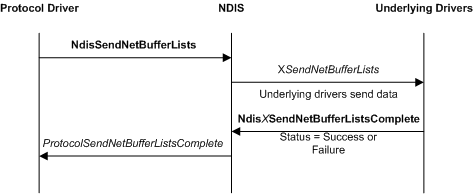Sending Data from a Protocol Driver
The following figure illustrates a protocol driver send operation, which involves a protocol driver, NDIS, and underlying drivers in a driver stack.

Protocol drivers call the NdisSendNetBufferLists function to send the network data that is defined in a list of NET_BUFFER_LIST structures.
A protocol driver must set the SourceHandle member of each NET_BUFFER_LIST structure to the same value that it passes to the NdisBindingHandle parameter. The binding handle provides the information that NDIS requires to return the NET_BUFFER_LIST structure to the protocol driver after the underlying miniport driver calls NdisMSendNetBufferListsComplete.
Before calling NdisSendNetBufferLists, a protocol driver can set information that accompanies the send request with the NET_BUFFER_LIST_INFO macro. The underlying drivers can retrieve this information with the NET_BUFFER_LIST_INFO macro.
As soon as a protocol driver calls NdisSendNetBufferLists, it relinquishes ownership of the NET_BUFFER_LIST structures and all associated resources. NDIS calls the ProtocolSendNetBufferListsComplete function to return the structures and data to the protocol driver. NDIS can collect the structures and data from multiple send requests into a single linked list of NET_BUFFER_LIST structures before it passes the list to ProtocolSendNetBufferListsComplete.
Until NDIS calls ProtocolSendNetBufferListsComplete, the current status of a protocol-driver-initiated send is unknown. A protocol driver temporarily releases ownership of all resources it allocated for a send request when it calls NdisSendNetBufferLists. A protocol driver should never attempt to examine the NET_BUFFER_LIST structures or any associated data before NDIS returns the structures to ProtocolSendNetBufferListsComplete.
ProtocolSendNetBufferListsComplete performs whatever postprocessing is necessary to complete a send operation. For example, the protocol driver can notify the clients, that requested the protocol driver to send the network data, that the send operation is complete.
When NDIS calls ProtocolSendNetBufferListsComplete, the protocol driver regains ownership of all of the resources associated with the NET_BUFFER_LIST structures that are specified by the NetBufferLists parameter. ProtocolSendNetBufferListsComplete can either free these resources (for example, by calling NdisFreeNetBuffer and NdisFreeNetBufferList) or prepare them for reuse in a subsequent call to NdisSendNetBufferLists.
Although NDIS always submits protocol-supplied network data to the underlying miniport driver in the protocol-determined order as passed to NdisSendNetBufferLists, the underlying driver can complete the send requests in random order. That is, every bound protocol driver can rely on NDIS to submit the network data that the protocol driver passes to NdisSendNetBufferLists in FIFO order to the underlying driver. However, no protocol driver can rely on the underlying driver to call NdisMSendNetBufferListsComplete in the same order.